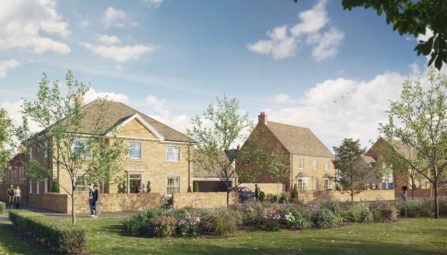
Mark Charter: Head of Residential Agency, Carter Jonas Oxford
2017 has proved to be a dichotomy for our local housing market. Although Oxfordshire has shown overall annual house price growth, we have undoubtedly been hit by declining transaction volumes following the two rounds of reform made to the calculation of stamp duty, implemented first in November 2014 and then in April 2016.
In addition, the broader economic and political turmoil that has ensued following the vote in favour of Brexit last year and then the snap General Election earlier this year has had an inevitable impact on buyer and vendor mentality.
First time buyers have unequivocally made it to the top of the Chancellor’s agenda, with Philip Hammond’s recent decision in November’s Autumn Budget to abolish stamp duty for first time buyers for properties under £300,000 and a tax reduction on properties under £500,000. In Oxfordshire terms, this end of the market has always performed well, but we could see more activity driven by first-time buyers in future.
That being said, the Chancellor potentially missed a trick in failing to incentivise empty nesters and downsizers, whose movements are heavily relied upon to free up much needed larger properties, and allow second steppers the chance to buy a family-sized home.
When it comes to the performance of the residential sales market within the city of Oxford itself, there are three distinct levels of activity. Flats and apartments under £600,000 are still incredibly popular, the mid-market up to £1.5m remains fairly strong – held in part by a shortage of stock, and unsurprisingly the market over £2m is slow and we have seen prices track back over the course of 2017.
Oxford’s desirability is helping it to weather the post-Brexit storm. However, in the past the area has been sought-after by London buyers, particularly from affluent boroughs, who wish for their children to attend the high-achieving private schools on offer in the county. Historically, much of the churn of the London market has come from international and domestic investment rather than the traditional owner occupiers and, as such, the capital has been the hardest hit by political volatility and fiscal strains, leaving the market wanting. This impact is felt in Oxford through the decline of the London buyer.
“…the Chancellor potentially missed a trick in failing to incentivise empty nesters and downsizers, whose movements are heavily relied upon to free up much needed larger properties.”
We are seeing more positivity in the lettings market with consistent demand for properties under £2,500pcm. The market above this price bracket is much more sensitive, a by-product of the aforementioned tighter London market and reduced budgets coming out of the capital.
As the population of Oxford continues to grow, thanks in part to its continuing appeal to businesses as a hub of innovation, we expect to see an increase in demand of medium and long-term rentals within the city centre. The rental market is perfectly placed for individuals here on a one to three year employment contract, providing them with flexibility should they wish to move on in the future. We have been advising landlords to be flexible to get the best results.
Domestically speaking across Oxfordshire there is an overall shortage of property on the market. Many sellers are adopting a wait and see approach and, instead of opting to spend on what would be a hefty stamp duty bill, they are extending or improving their existing homes with a view to selling down the line once there is more clarity surrounding the UK’s exit from the EU and its economic implications – thus bringing about a boost in activity and perhaps with it, an increase in house prices.
That said, there is still a growing demand for property, especially from first and second time buyers with typical jobs paying modest incomes. This is ideally where the new homes piece comes in. Firstly (and obviously) in a market where few are moving, empty new homes are more accessible than second hand stock. Secondly, buyers like the convenience of having lower energy bills, less maintenance and practically sized rooms. Finally and most crucially the new build properties we are selling are typically valued between £350,000 and £800,000 – a price bracket proving to be most attractive and active in the current market. As example, earlier in the year we released eight houses at a site near Chinnor in South Oxfordshire and five of them went under offer in the first few weeks.
If asked to describe the current property market here in Oxfordshire, we would say cooling, cautious and conservative. Looking ahead motivated vendors will need to be realistic with guide prices in order to stimulate interest. Existing market conditions are likely to prevail, coinciding perhaps with a further increase in interest rates, compounding the current shortage of stock coming to the market in 2018, which could lead to more competitive bidding for best in class or unique properties.
Regional nuance aside, Oxfordshire has an incredible global reputation as a centre of educational excellence and innovative business. Moving forward, this reputation will certainly help to protect the market and transaction levels – especially as a number of new businesses and their employees look to relocate here.
More in Residential Property

Welcome to B4, Grainger
Graingerplc is the UK’s largest listed residential landlord and leader in the fast-growing build-to-rent sector, providing c.11,100 rental homes to over 25,000 customers and are delighted to soon be launching its very first development in Oxford, The Kimmeridge.

New public park and street to unlock new homes at Oxford...
The reserved matters application (RMA) for Oxford North’s Canalside new public park and residential street, made by Thomas White Oxford, the development company of St John’s College, has been resolved to be approved by Oxford City Council’s planning committee at a meeting held on Tuesday 16 August 2022.

Shared Ownership Scheme Offers Hope for Local Home Seekers
Blenheim Estate’s shared ownership scheme at Park View, Woodstock is offering local people an affordable way to buy their own property and stay in the area.
From this author

UK Biomass Potential for BECCS Land Occupier Survey
Carter Jonas have been commissioned to provide research and information on the future of Biomass and the potential supply of feedstock for power generation within the UK.

Are we overcoming the polarisation and prejudice that later living schemes...
In a 2018 article, we highlighted that communities are too often unbalanced and polarised and warned, ‘If age segregation is defining our communities today, then action must be taken to prevent it escalating further’. Three years on, Planning & Development Insite considers whether society and our industry has actually made any progress.

Biodiversity, Amenity and Diversification
The tree drivers for land purchases you may not have considered.


